Long before AI was a buzzword included in every handset’s marketing material, a few lucky phones already offered automatic transcripts of voice recordings. But the arrival of on-device AI has extended that feature to more phones and more apps, including the Phone app itself, while also adding auto-generated summary features to the mix.
All three of the major smartphone makers — Apple, Google and Samsung — offer some type of voice recording app on their flagship phones with real-time transcription as part of the feature set. Those phones now record and transcribe phone calls, too. And summary tools that tap into AI to produce recaps of conversations, articles, recordings and more have become commonly available on iPhones, Pixels and Galaxy S devices alike.
But which phone offers the most complete set of transcription and summarization tools? To find out, I took an iPhone 15 Pro, Pixel 9 and Galaxy S25 Plus loaded with the latest available version of their respective operating systems, and put each device through a series of tests.
If you need a phone that can turn your speech into text or cut through a lengthy recording to bring you the highlights, here’s which phone is most up to the job.
Test 1: Transcribing and summarizing a phone call
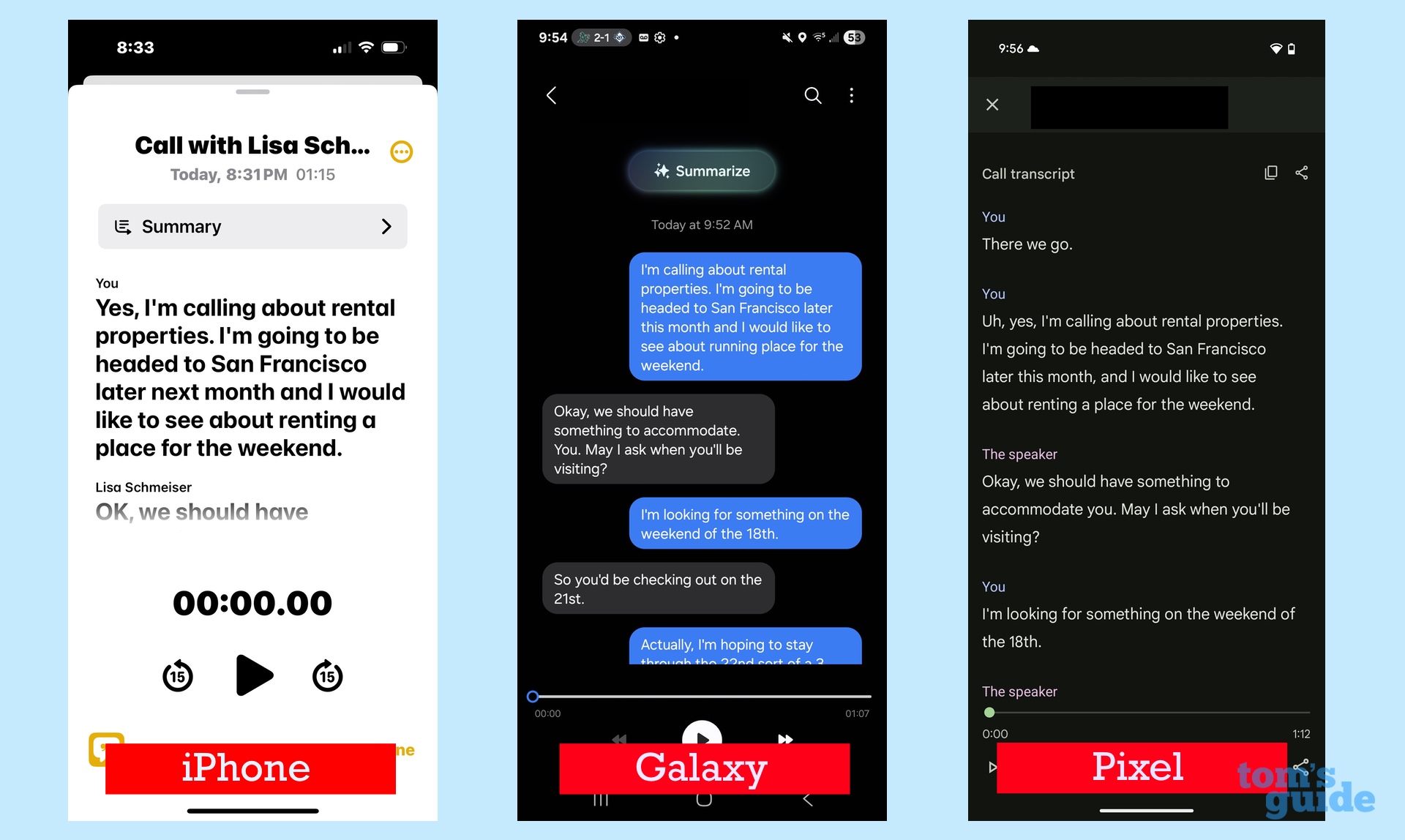
I wrote out a scripted phone call, handed one copy to my wife and then scurried outside to call her three separate times from the iPhone, Pixel and Galaxy S device. By scripting out our conversation, we could see which on-board AI provided a more accurate transcript. And after each call, I took a look at the AI-generated summary to see if it accurately followed our discussion of rental properties in the San Francisco Bay Area.
The iPhone’s transcript was the most muddled of the three, with more instances of incorrect words and a lack of proper punctuation. The biggest misstep, though, was mixed up words that my wife and I had said, as if we had been talking over each other. (We had not.) Because I was calling someone in my Contacts, though, the iPhone did helpfully add names to each speaker — a nice touch.
The transcripts from the Pixel 9 and Galaxy S25 Plus were equally accurate when compared to each other. Samsung displays its transcripts as if you’re looking at a chat, with different text bubbles representing each speaker. Google’s approach is to label the conversation with “you” and “the speaker.” I prefer the look of Google’s transcript, though I appreciate that when my wife and I talked expenses, Galaxy AI successfully put that in dollar amounts. Google’s Gemini just used numbers without dollar designations.
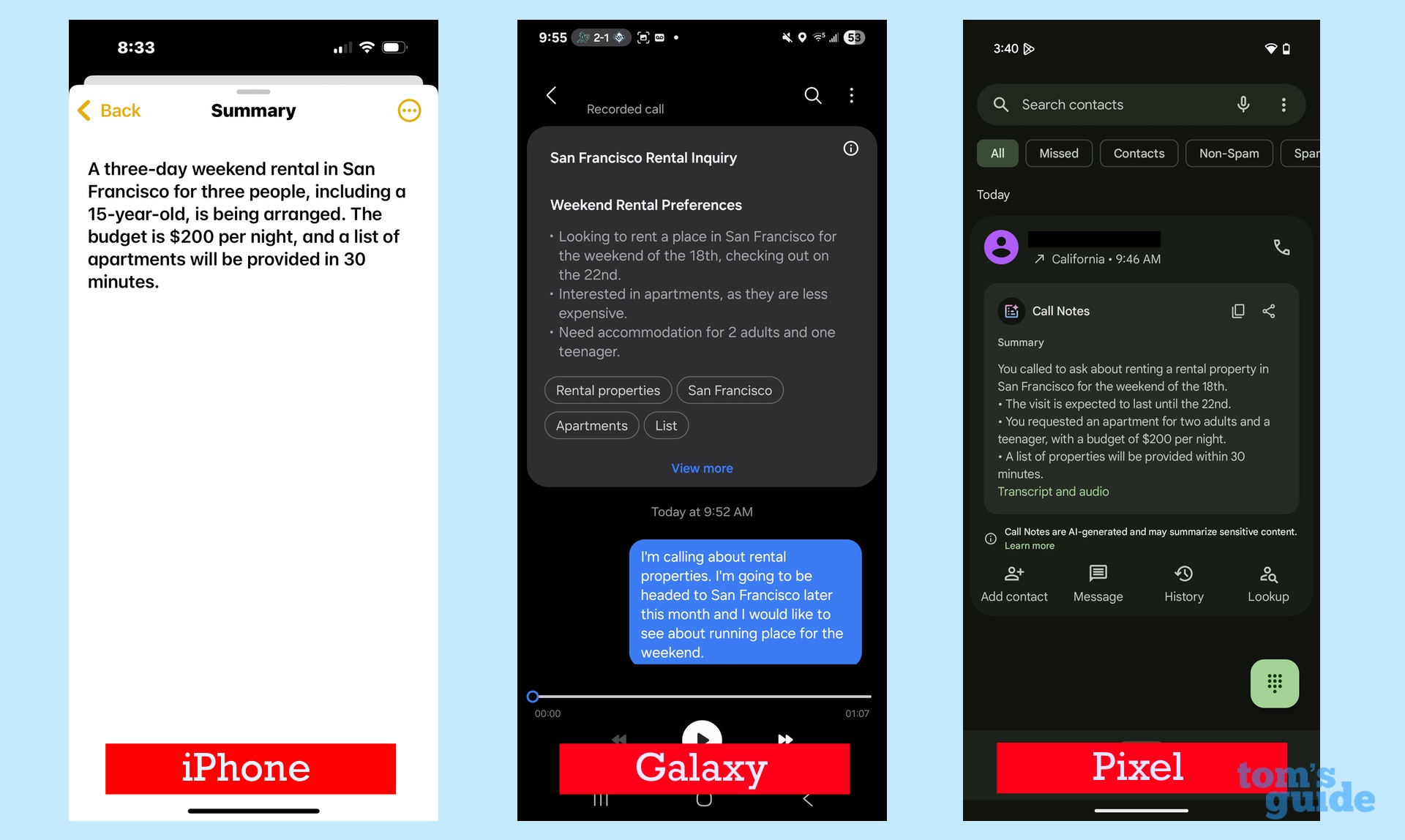
As for the summaries, the one provided by iPhone accurately summed up the information I requested from my wife. The Galaxy AI summary was accurate, too, but left out the budget amount, which was one of the key points of our discussion. Google’s summary hit the key points — the budget, the dates and who was going on the trip — and also put the summary in second person (“You called to ask about a rental property…"). I found that to be a personal touch that put Google’s summary over the top.
I will point out that the iPhone and Galaxy S25 Plus summaries appeared nearly instantly after the call. It took a bit for the Pixel 9 to generate its summary — not a deal-breaker, but something to be aware of.
Winner: Google — The Pixel 9 gave me one of the more accurate transcripts in a pleasing format, and it personalized a summary while highlighting the key points of the conversation.
Test 2: Transcribing and summarizing voice recordings
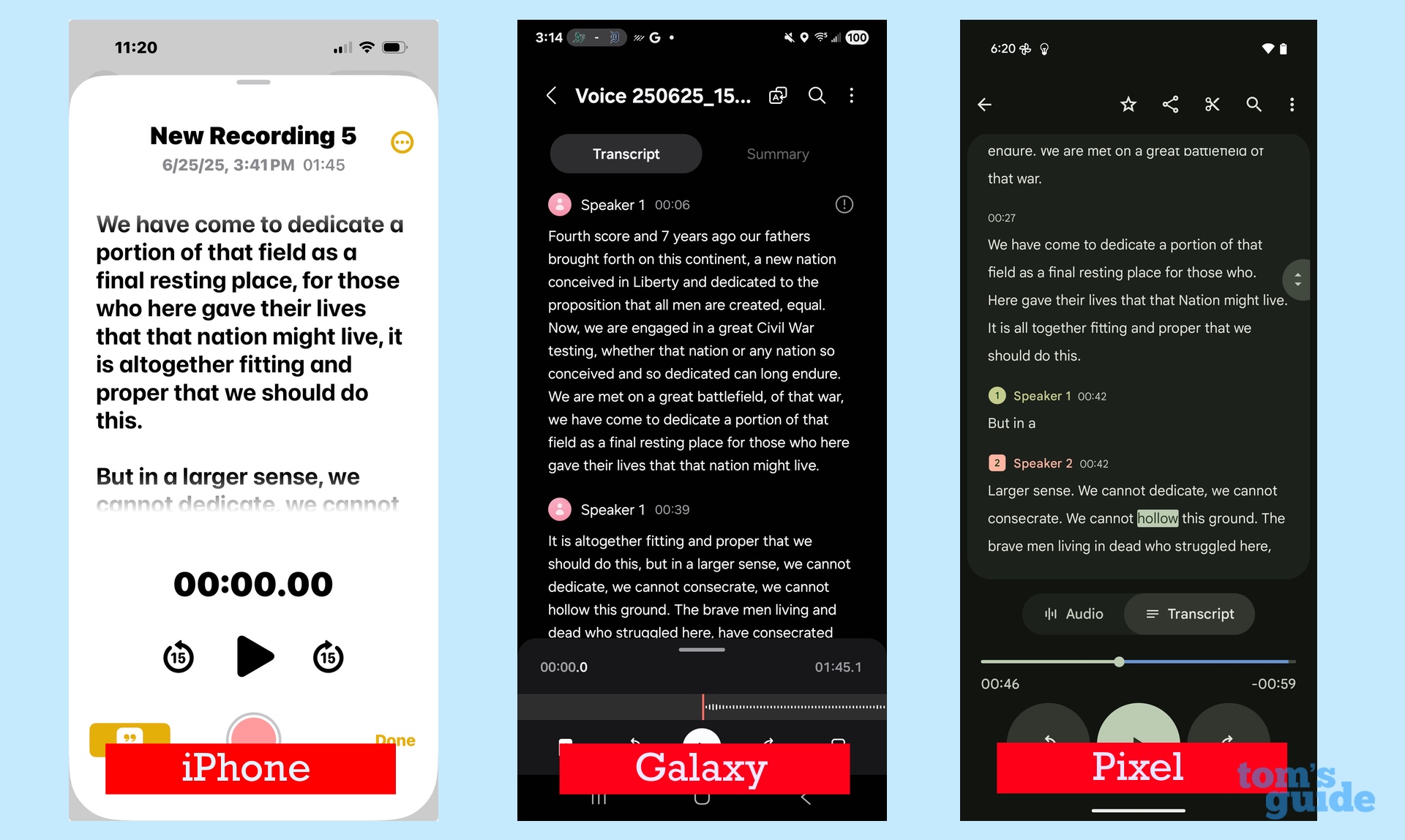
I launched the built-in recording apps on each phone all at the same time so that they could simultaneously record me reading the Gettysburg Address. By using a single recording, I figured I could better judge which phone had the more accurate transcript before testing the AI-generated summary.
The transcript from Samsung’s Voice Recorder app suffered from some haphazard capitalization and oddly inserted commas that would require a lot of clean-up time if you need to share the transcript. Google Recorder had the same issue and, based on the transcript, seemed to think that two people were talking.
The iPhone’s Voice Memos app had the cleanest transcript of the three, though it did have a handful of incorrectly transcribed words. All three recording apps had issues with me saying “nobly advanced,” with the Galaxy S25 Plus thinking I had said “nobleek, advanced” and the iPhone printing that passage as “no league advanced.” Still, the iPhone transcript had the fewest instances of misheard words.
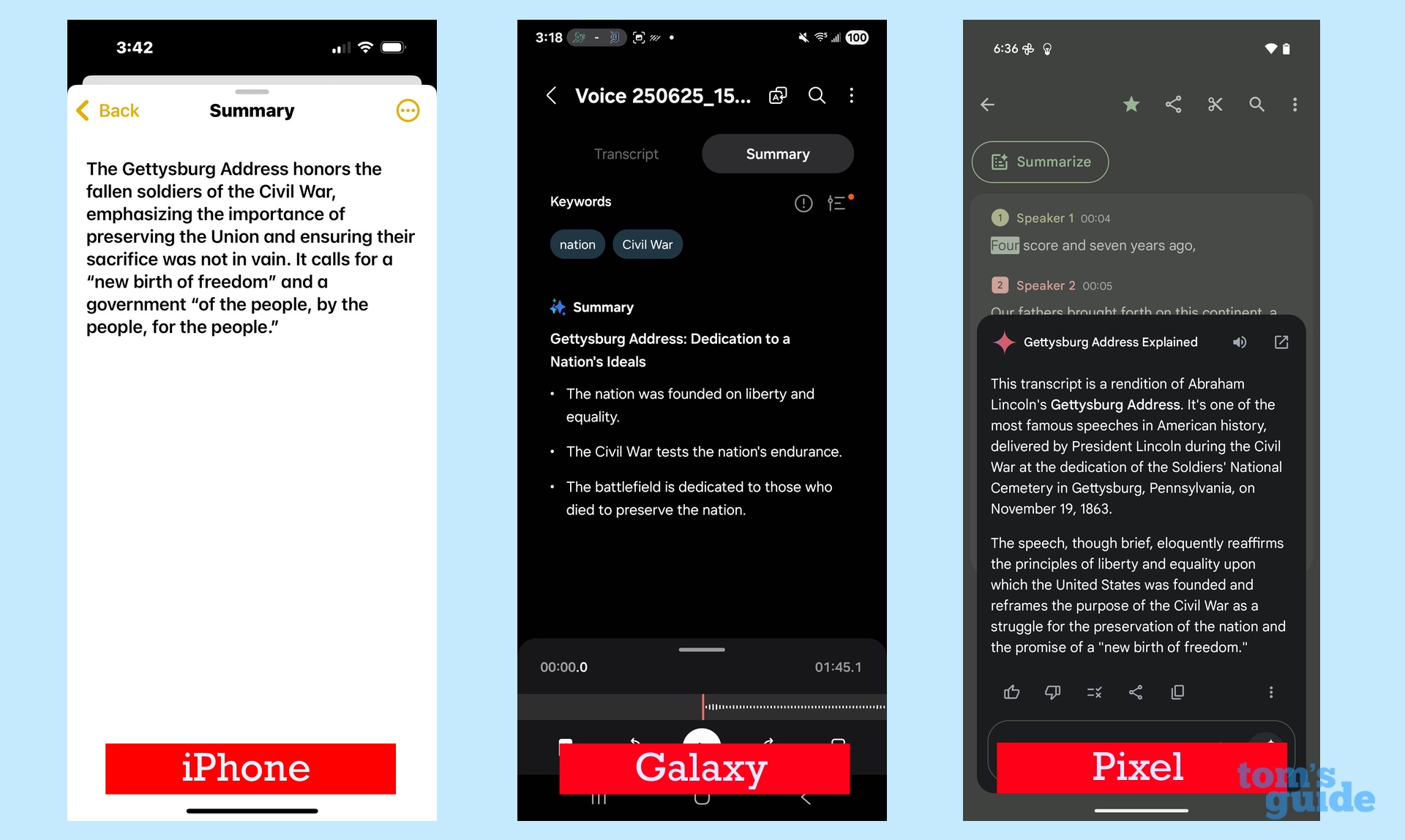
As for summaries, the Galaxy AI-generated version was fairly terse, with just three bullet points. Both the Pixel and the iPhone recognized my speech as the Gettysburg Address and delivered accurate summaries of the key points. While getting a summary from the iPhone takes some doing — you have to share your recording with the iOS Notes app and use the summary tool there — I preferred how concise its version was to what the Gemini AI produced for the Pixel.
Winner: Apple — Not only did the iPhone have the best-looking transcript of the three phones, its summary was also accurate and concise. That said, the Pixel was a close second with its summarization feature, and would have won this category had it not heard those phantom speakers when transcribing the audio.
Test 3: Transcribing multiperson recordings
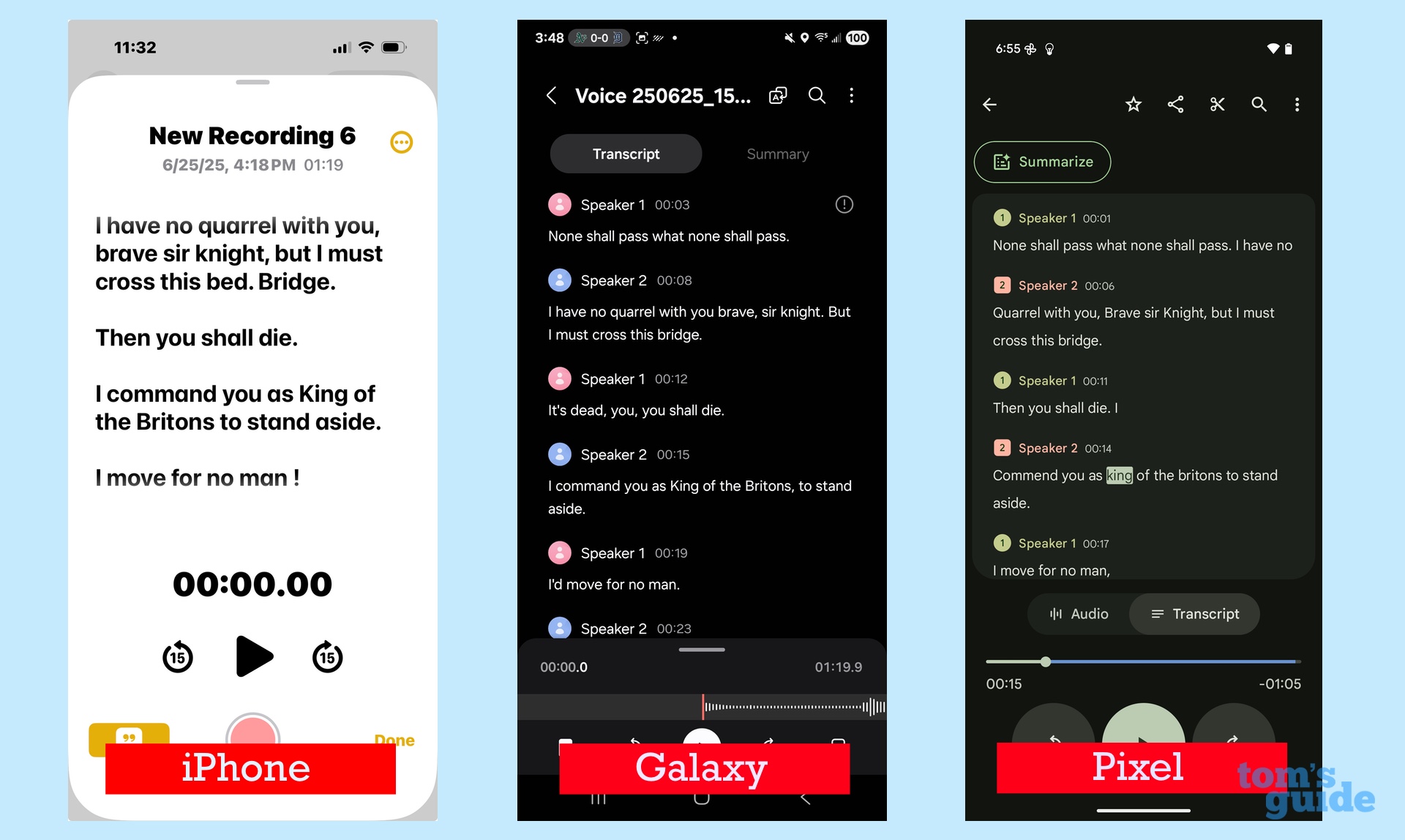
Why keep testing the transcription feature when we’ve already put the recording apps through their paces? Because there could come a time when you need to record a meeting where multiple people are talking and you’ll want a transcript that recognizes that.
You may be in for a disappointing experience if the transcripts of me and my wife recreating the Black Knight scene from “Monty Python and the Holy Grail” are anything to go by. Both the Galaxy and Pixel phones had problems recognizing who was speaking, with one speaker’s words bleeding into the next. The Pixel 9 had more than its share of problems here, sometimes attributing an entire line to the wrong speaker.
The Galaxy had more incorrectly transcribed words, with phrases like “worthy adversary” and “I’ve had worse” becoming “where the adversary is” and “5 had worse,” respectively. The Pixel had a few shockers of its own, but its biggest issue remained the overlapping dialogue
At least, those phones recognized two people were talking. Apple Intelligence’s transcript ran everything together, so if you’re working off that recording, you’ve got a lot of editing in your future.
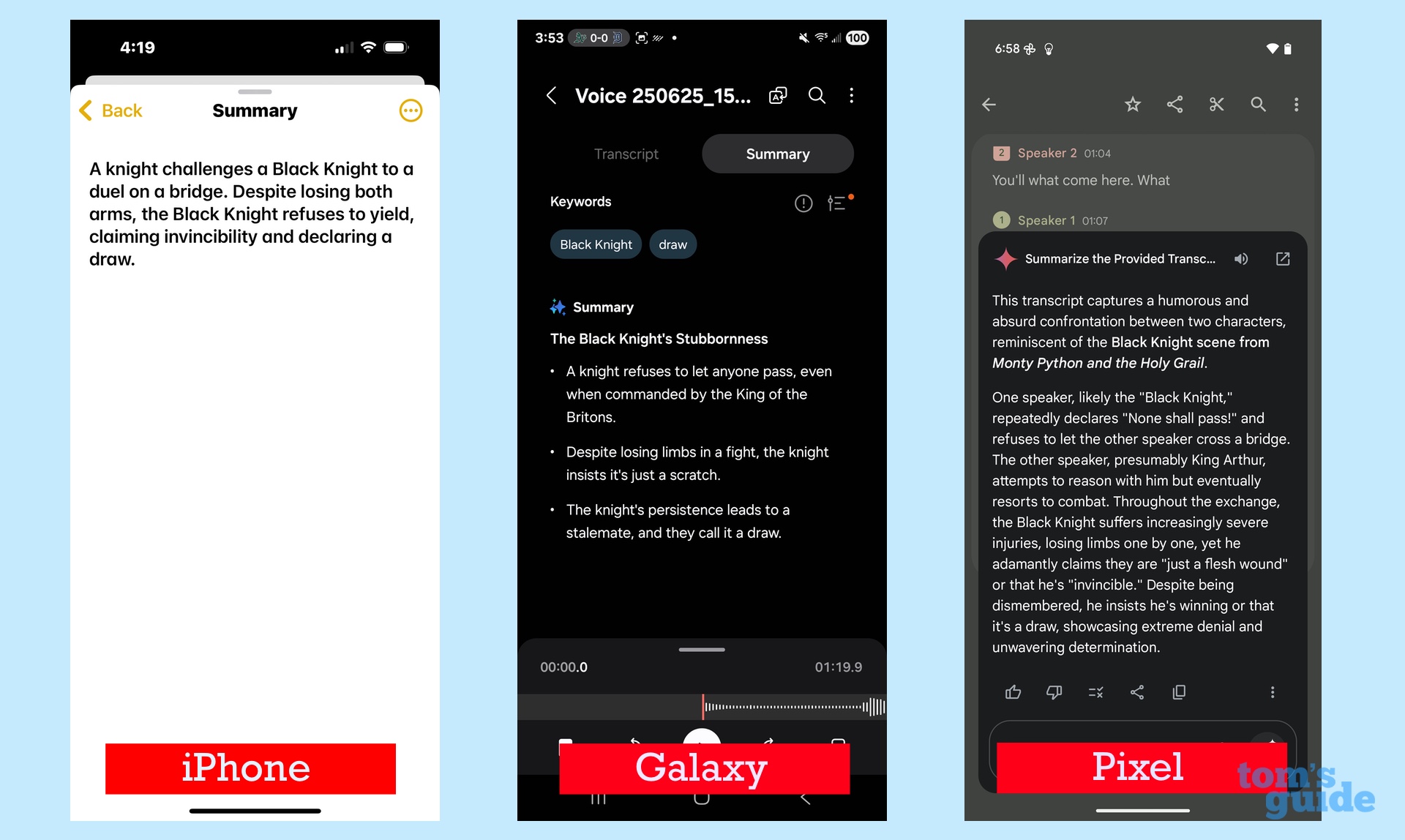
With this test, I was less interested in the summarization features, though the Pixel did provide the most accurate one, recognizing that the dialogue was “reminiscent” of “Monty Python and the Holy Grail.” The Galaxy AI-generated summary correctly deduced that the Black Knight is a stubborn person who ignores his injuries, but wrongly concluded that both speakers had agreed the fight was a draw.
The iPhone issued a warning that the summarization tool wasn’t designed for an exchange like this and then went on to prove it with a discombobulated summary in which the Black Knight apparently fought himself.
Winner: Samsung — Galaxy AI had easier-to-correct errors with speakers’ lines bleeding into each other. The Gemini transcript was more of a mess, but the summary nearly salvaged this test for Google.
Test 4: Summarizing emails
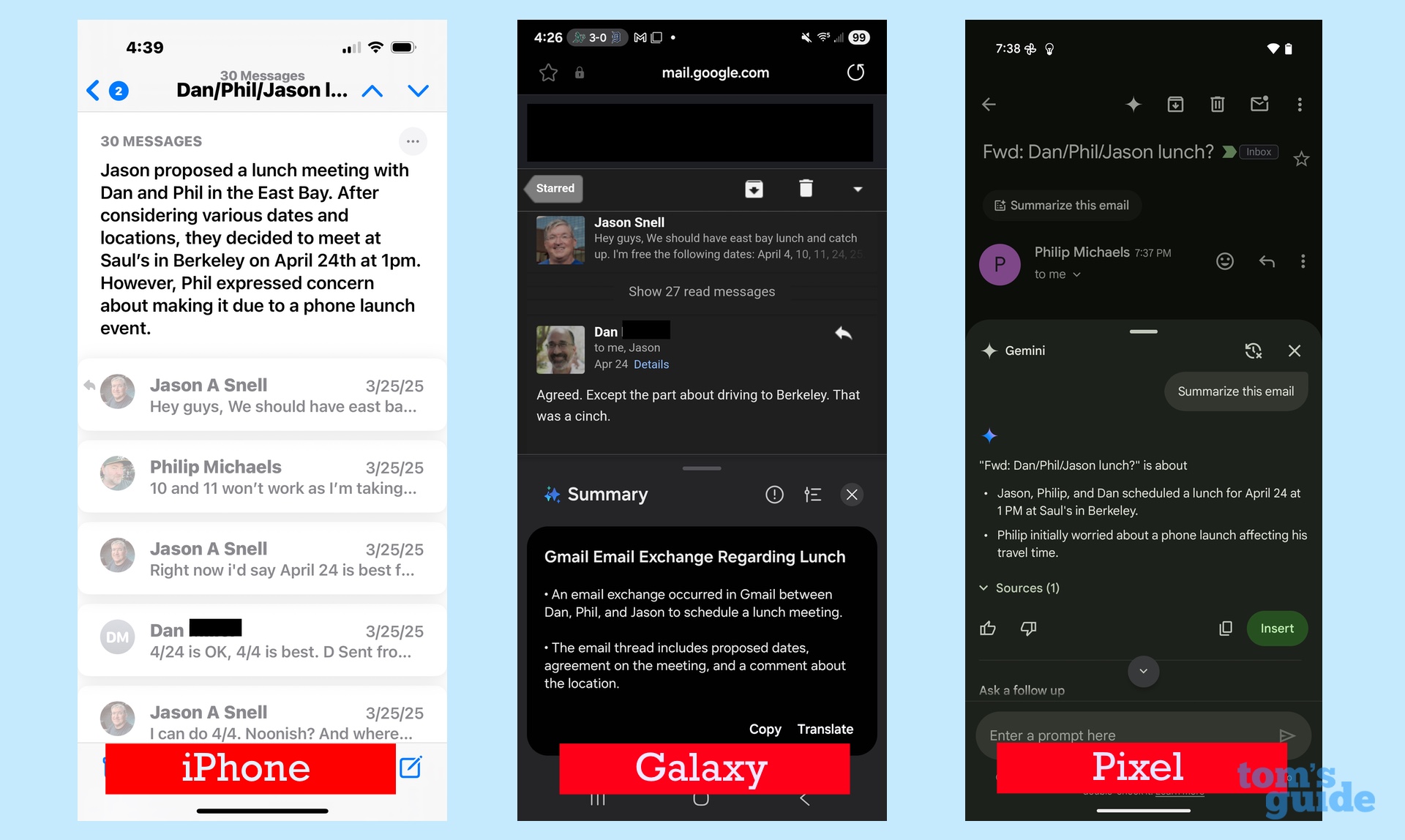
Of all the promised benefits of AI on phones, few excite me more than the prospect of a tool that can read through email chains and surface the relevant details so that I don’t have to pick through each individual message. And much to my delight, two of the three phones I’ve tested stand out in this area.
I’m sad to say it isn’t the Galaxy S25 Plus. I found the feature a bit clunky to access, as I had to use the built-in Internet app to go to the web version of Gmail to summarize an exchange between me and two friends where we settled on when and where to meet for lunch. Galaxy AI’s subsequent summary included the participants and what we were talking about, but it failed to mention the date and location we agreed upon.
Both the Pixel and the iPhone fared much better. Gemini AI correctly listed the date, time and location of where we were going to meet for lunch. It even spotted a follow-up email I had sent en route warning the others that I was running late. Apple Intelligence also got this feature right in the iPhone’s built-in Mail app.
I think the Pixel has the better implementation, as getting a summary simply requires you to tap the Gemini button for all the key points to appear in a window. iOS Mail’s summary feature lives at the top of the email conversation so you’ve got to scroll all the way up to access your summary.
Winner: Google — The Pixel and the iPhone summarized the message chain equally well, but Google’s implementation is a lot easier to access.
Test 5: Summarizing web articles
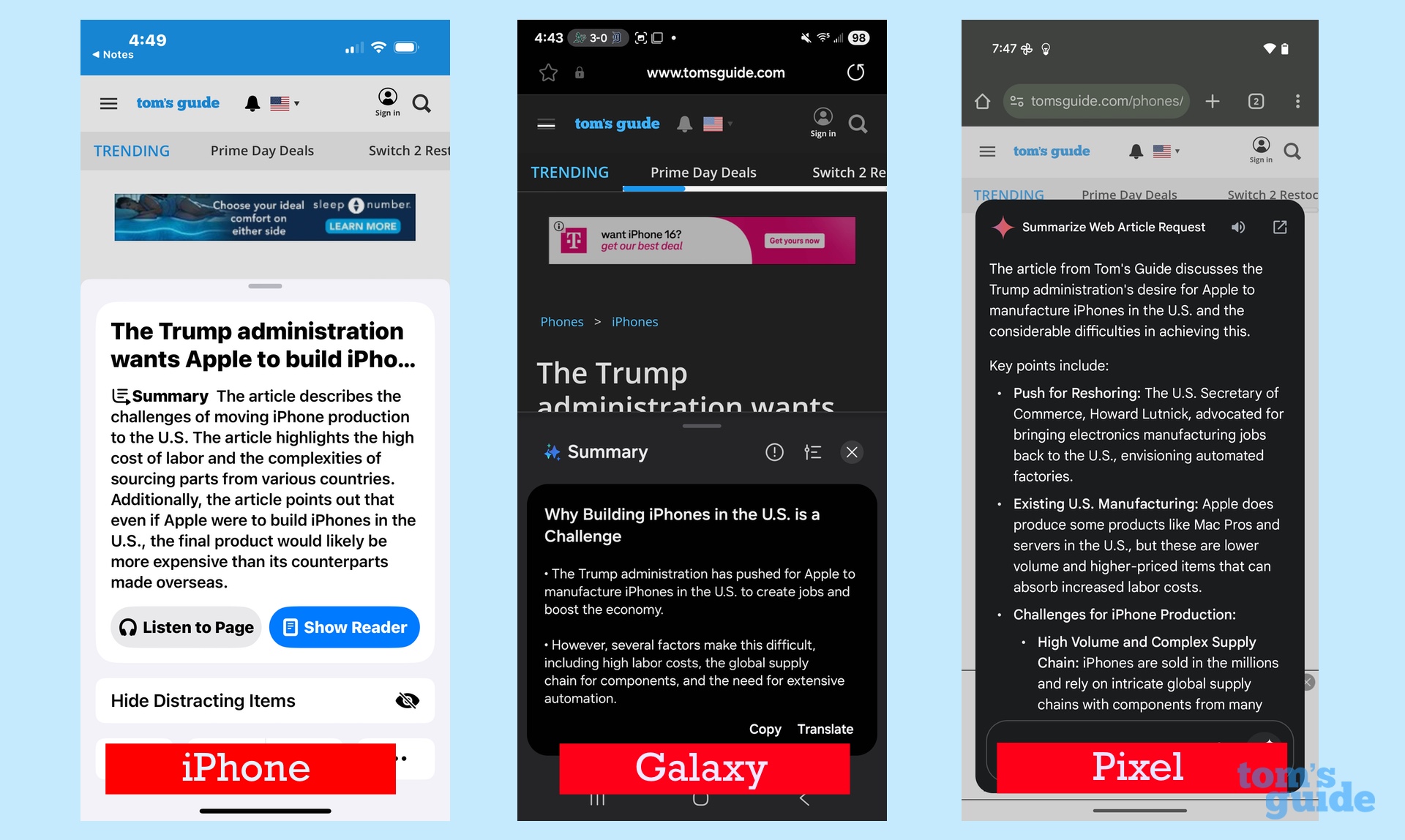
In theory, a summary tool for web pages would help you get the key points of an article quickly. The concern, though, is that the summary proves to be superficial or, even worse, not thorough enough to recognize all the key points. So how do you know how accurate the summary is?
I figured to find out, I’d run one of my own articles through the summary features of each phone — this article about the push to move iPhone manufacturing to the U.S., specifically. I mean, I know what I wrote, so I should be in a good position to judge if the respective summary features truly got the gist of it.
Galaxy AI did, sort of, with its summary consisting of two broadly correct points that the Trump administration wants to move phone manufacturing to the U.S. and that high labor costs and global supply chain automation are the big roadblocks. That’s not horribly inaccurate, but it is incomplete, as the article talked more about the lack of dedicated assembly plants and equipment in the U.S.
The iPhone’s summary — appearing as a tappable option in the menu bar of Safari — was a little bit more detailed on the key roadblock, while also noting the potential for rising prices of U.S.-built phones.
However, the summary provided via Gemini AI is far and away the most substantive. It specifically calls out a push for reshoring, notes what Apple already produces in the U.S., and highlights multiple bullet points on the difficulties of U.S. phone manufacturing.
Winner: Google — Summaries don’t always benefit from being brief, and the Galaxy AI-generated summation of my article hits key points without sacrificing critical details and explanations. You can read that summary and skip my article — please don’t, it would hurt my feelings — and still get a good grip on what I had written.
Test 6: Note summaries
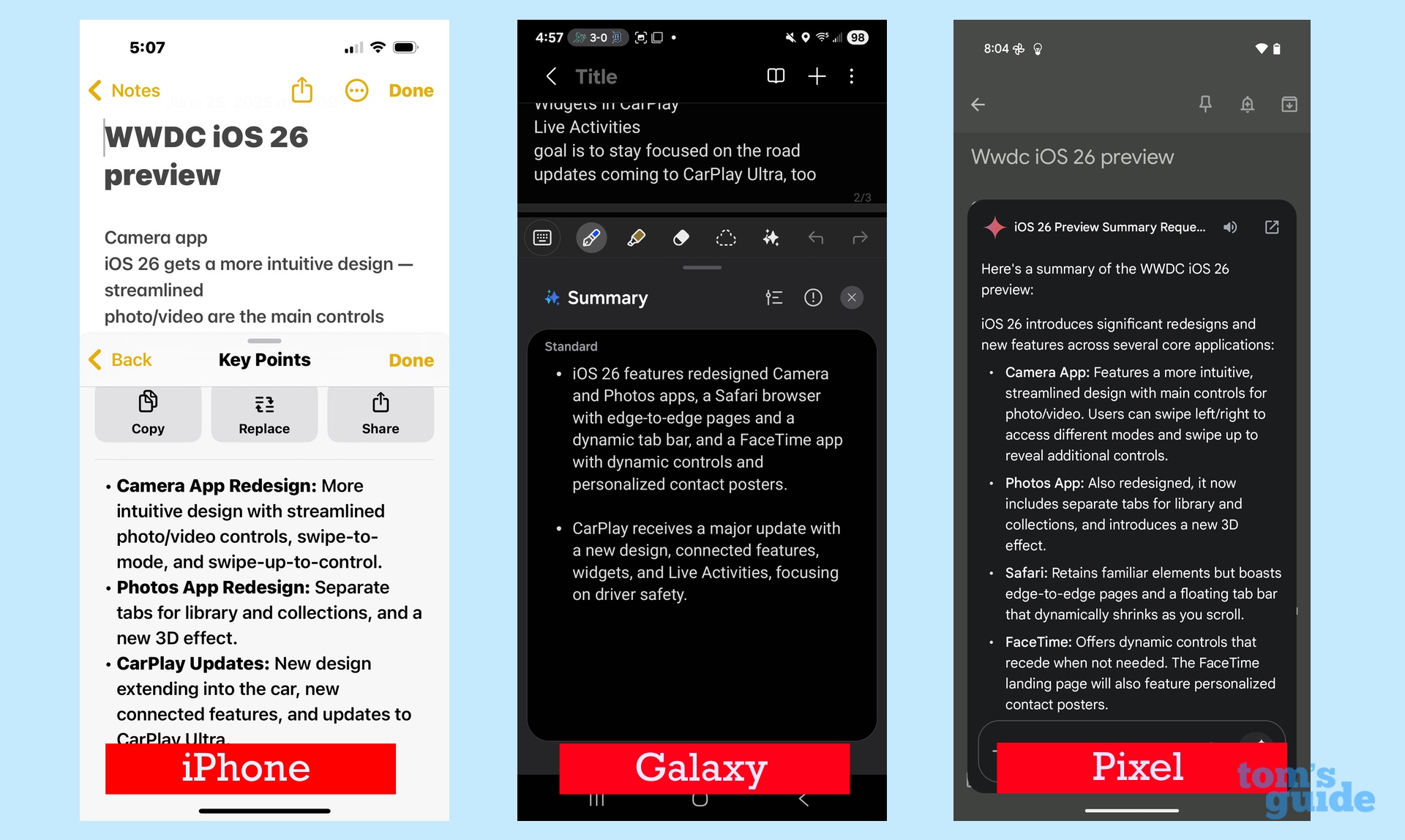
Sometimes, notes can be so hastily jotted down, you might have a hard time making sense of them. An ideal AI summary tool would be able to sort through those thoughts and produce a good overview of the ideas you were hoping to capture.
If you remember from our AI Writing Tools test, I had some notes on the new features in iOS 26 that I used to try out auto-formatting features provided by each phone’s on-device AI. This time around, I tried out the summary features and found them to be generally OK, with one real standout.
Both Galaxy AI and Apple Intelligence turned out decent summaries. When I selected the Key Points options in Writing Tools for iOS Notes, the iPhone featured a good general summation of changes in iOS 26, with particular attention paid to the Safari and FaceTime enhancements. Other descriptions in the Apple Intelligence-produced summary were a bit too general for my tastes.
I did like the concise descriptions in the Galaxy AI summary, where my lengthy notes were boiled down to two bullet points summing up the biggest additions. It’s not the most detailed explanation, but it would work as an at-a-glance synopsis before you dive into the meat of the notes themselves.
Gemini AI on board the Pixel 9 struck the best overall mix between brevity and detail. Google’s AI took the bullet points of my original notes and turned them into brief descriptions of each feature — a helpful overview that gets to the heart of what I’d be looking for in a summary.
Winner: Google — While Galaxy AI scores points for getting right to the point in its summary, the more useful recap comes from Gemini AI’s more detailed write-up.
Transcription and summary tools winner
If we had restricted these tests to transcripts, it might have been a closer fight, as both Apple and Samsung held their own against Google in converting recordings to text. But throw summaries into the mix, and Google is the clear winner, taking the top spot in four of our six tests. Even in the tests where the Pixel was bested by either the iPhone or the Galaxy S25 Plus, it didn’t lag that far behind.
Some of this comes down to what you prefer in a summarization tool. If it’s concise summaries, you may be more favorably inclined to Galaxy AI than I was. Apple Intelligence also shows some promise that would benefit from fine-tuning to make its tools easier to access. But for the best experience right now, Google is clearly the best at transcription and summarization.
.png)
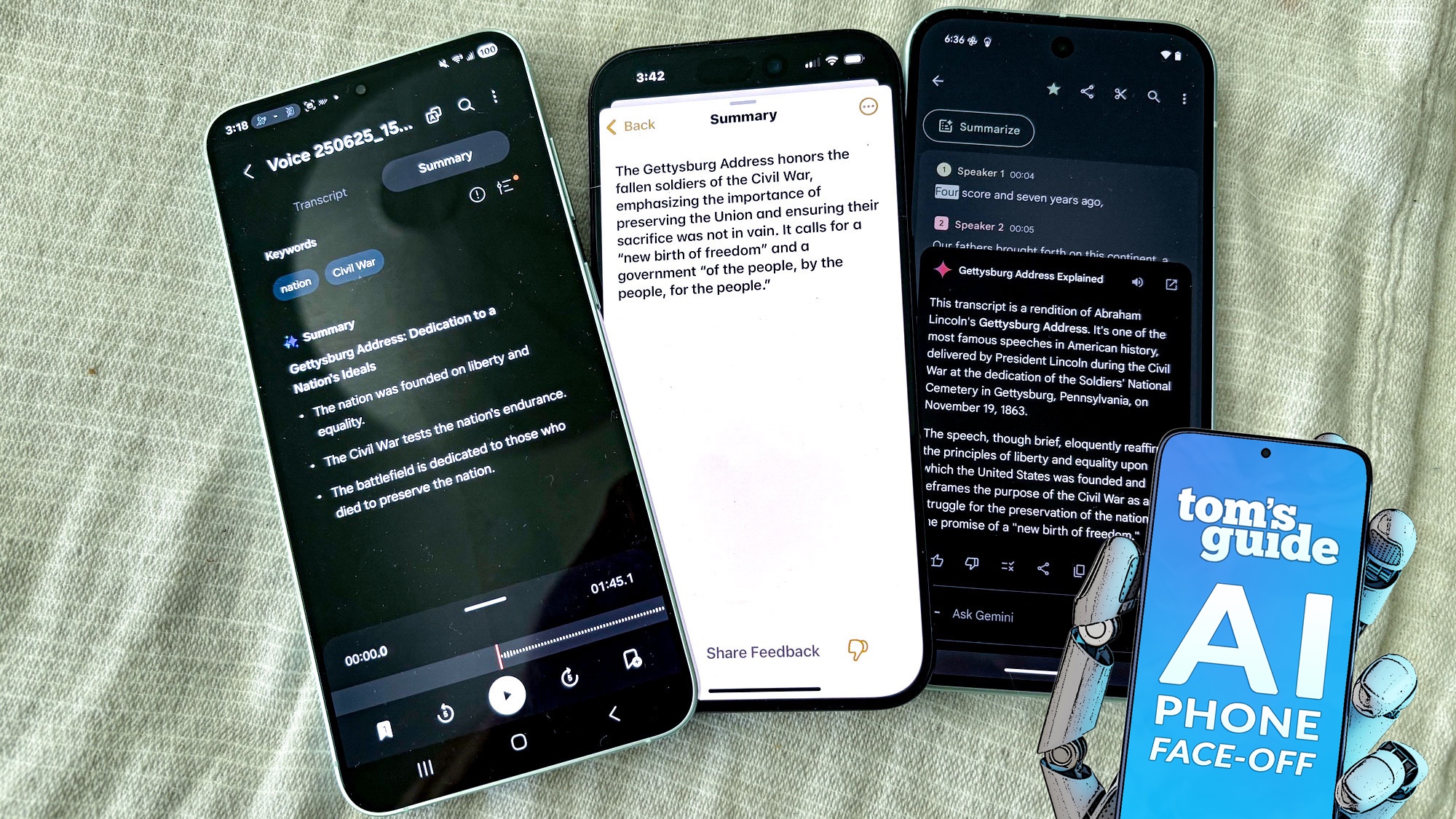
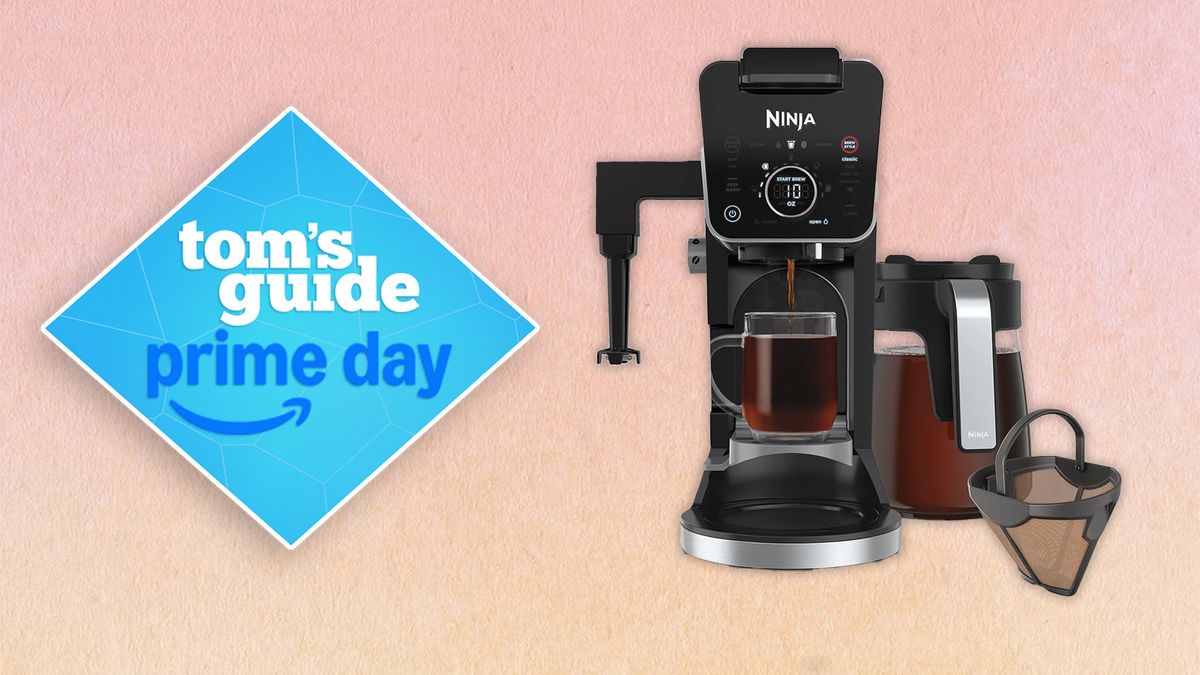

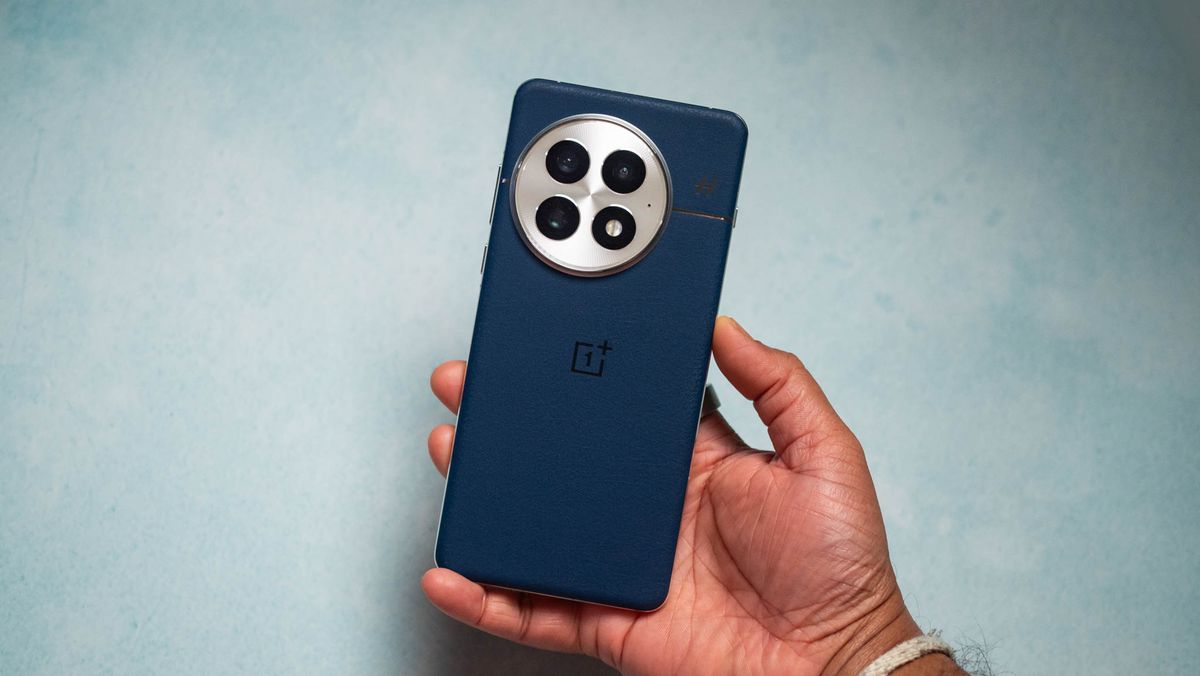







 English (US) ·
English (US) ·